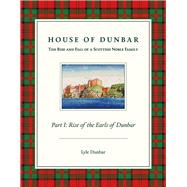House of Dunbar Part I - Rise of the Earls of Dunbar
, by Dunbar, Lyle- ISBN: 9781483563510 | 1483563510
- Cover: Hardcover
- Copyright: 3/31/2016
Do you know what your last name means? How did you get your last name? Where did your ancestors originate? Do you have any connections to royalty in your family history? Did your ancestors make any contributions to history? I thought about all of those questions, and went looking for the answers related to my Dunbar family name. I discovered that “Dunbar” meant “fort on a hill” in the old Gaelic language of Scotland. This name was given to Dunbar Castle, as well as the adjacent town of Dunbar, in southeast Scotland. The owners of Dunbar Castle in the 11th to 15th centuries were Scottish nobles known as the Earls of Dunbar because the name identified the location of their land holdings. By about 1300 in the Middle Ages, surnames were adopted to distinguish individuals within the growing population. The families of the Earls of Dunbar adopted the surname of Dunbar. Most of the Dunbars in the world got their name handed-down from these ancient Earls of Dunbar and the location of Dunbar Castle and Dunbar town.
The author refers to the Dunbar family as the “House of Dunbar” because it was more than a Scottish clan. The Earls of Dunbar were nobility with a line of descent from ancient Scottish and English kings. They played a prominent role in Scottish and English history in the Middle Ages. The Earls became one of the wealthiest and most powerful families in Scotland by the 15th century, which accounts for the word “Rise” of a Scottish noble family in the title. But the most distinguishing feature of the House of Dunbar was its loss of titles and power, never to be regained, in the mid-15th century, which accounts for the word “Fall” in the title. The author’s House of Dunbar story is told in the context of famous people, places, and historical events in three separate parts. In Part I-Rise of the Earls of Dunbar, the book covers the early history of Scotland, the rise to power of the Earls of Dunbar, and the forfeiture of the Earldom of Dunbar in 1435. In Part II-After the Fall of the Earldom of Dunbar, the book covers the turbulent history in Scotland after the forfeiture of the Dunbar Scottish earldom until the mid-1700s when there was a major immigration of Scottish people, including the author’s Dunbar ancestor, to America. In Part III-Coming to America, the book covers the story of Scottish immigration to America, and the author’s Scotch-Irish Dunbar family history in America from the mid-1700’s over eight generations to the present day.
Those with the Dunbar surname should read this story to explore where they fit in the House of Dunbar. Those interested in Scottish history will get an overview plus a description of the role of the Earls of Dunbar in that history. There were many noble families in Scotland, but the Dunbar story is unique due to the rise of the earls to the highest levels of power, and their fall from power, never to be regained. Those with other Scottish names and ancestry may be encouraged to explore their own family history to find their connections to famous people and places in Scottish history.







